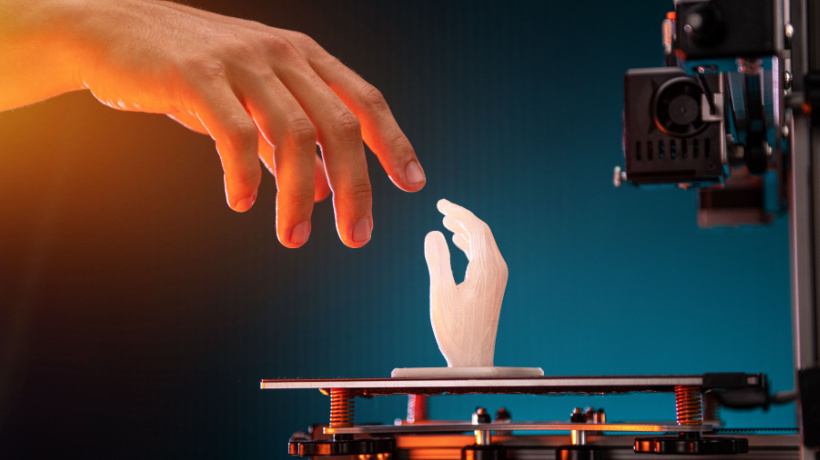Fusing The Digital And The Physical
3D printing is transforming the way we approach training and development, offering hands-on learning and cost-effectiveness. This innovative technology is creating customized tools, equipment, and realistic models across various industries. Combining 3D printing with eLearning provides an immersive and interactive experience that engages learners in a hands-on approach to learning. By incorporating 3D printing into eLearning, educators can enhance the learning experience of the learners and help them develop important skills such as problem-solving, critical thinking, and creativity.
The Uses Of 3D Printing In eLearning
Here are some ways in which 3D printing can be used with eLearning:
- 3D printing enhances understanding
Medical students can print 3D organ models for better comprehension of structure and function. - Rapid prototyping
Design, architecture, and engineering students can quickly iterate and refine ideas through 3D printing. - Customization and personalization
Learners can create custom designs, like fashion students printing their own clothing designs. - Collaborative learning
3D printing facilitates peer and instructor feedback, promoting collaborative learning. - Tangible visualization
Engineering students can print 3D models of machine parts for interactive and concrete comprehension. - Personalized learning
3D printing enables the individualized creation of models, designs, and objects. - Hands-on education
3D printing engages learners through experiential learning, developing critical thinking and problem-solving skills.
Overall, 3D printing enhances eLearning by providing a hands-on approach to learning that engages creativity and problem-solving skills. Incorporating 3D printing into eLearning prepares learners for the demands of the modern workforce.
Future Uses Of 3D Printing In Corporate Learning
The future of 3D printing in corporate digital training is bright. It can be used in the following ways:
- Prototyping and product development
3D printing can rapidly create physical prototypes of new products, allowing designers to test and refine their ideas before mass production. - Training and simulations
3D printing creates realistic models of complex equipment or machinery for hands-on training. - Customized tools and equipment
3D printing allows the creation of customized tools and equipment to meet specific needs. - Marketing and branding
3D printing creates unique and eye-catching promotional items and marketing materials.
In sum, 3D printing can be a valuable tool for corporate education, allowing companies to improve their product development processes, provide hands-on training, and create customized tools and equipment. By incorporating 3D printing into their training and development programs, companies can stay ahead of the curve and prepare their employees for the challenges of the modern workplace.
The Benefits And Challenges Of Incorporating 3D Printing Into Corporate Training
Here are some of the main benefits and issues to consider when using 3D printing in corporate digital training:
The Benefits
- Hands-on learning
3D printing allows for a hands-on approach to learning, enabling employees to create physical models of concepts and ideas, and practice using specialized equipment. - Customization
3D printing allows for the creation of customized tools, equipment, and products, enabling companies to tailor their training and development programs to their specific needs. - Cost-effective
3D printing can be a cost-effective way to create prototypes and models, reducing the need for expensive equipment and materials. - Time-efficient
3D printing can be a time-efficient way to create prototypes and models, reducing the time needed to develop and test new products. - Innovation
3D printing can encourage innovation and creativity, enabling employees to experiment with new ideas and develop new solutions.
The Challenges
- Cost
While 3D printing can be cost-effective in some cases, it can also be an expensive technology to invest in, particularly for smaller companies. - Training
3D printing requires specialized knowledge and training, and companies may need to invest in training programs for their employees to ensure they can use the technology effectively. - Quality control
3D printing can be prone to errors and inconsistencies, particularly when creating larger or more complex models. - Intellectual property
3D printing raises questions about intellectual property and copyright, particularly when creating models of existing products or designs. - Sustainability
3D printing can be environmentally unsustainable if not properly managed, as it often requires the use of plastic materials that can be difficult to recycle.
In general, while 3D printing can offer many benefits for corporate digital training, it is important to carefully consider the costs and potential issues associated with this technology. By weighing these factors carefully, companies can make informed decisions about whether 3D printing is the right choice for their training and development programs.
3D Printing Transforming Training
Here are some examples and statistics that demonstrate how 3D printing is transforming training and development:
- Advanced manufacturing training
3D printing is used to train workers in manufacturing techniques. GE reduced training time by 80% and costs by 90% with their 3D-printed engine training tool. - Healthcare training
3D printing creates realistic models of human anatomy for medical training. The University of Rochester Medical Center creates models of complex cardiac conditions to help plan surgeries. - Engineering training
3D printing teaches engineering students about complex structures and design. The University of Southern California developed a 3D-printed model of a spinal cord for detailed study. - Customized tools and equipment
3D printing creates customized tools and equipment for training. Airbus created a tool to install electrical wiring in aircraft cabins, reducing the required time by 30%. - Growth of the 3D printing market
The 3D printing market is projected to reach $34.8 billion by 2024 due to increased demand in the healthcare, manufacturing, and education industries.
Conclusion
By using 3D printing, companies can create effective and engaging training programs that transform eLearning and provide many benefits for employees. However, there is still much to learn about its best practices, impact on learning outcomes, scalability, and sustainability, as further research is needed. Despite these challenges, the future of 3D printing in corporate digital training looks promising, with the potential for expansion into various industries beyond traditional technical roles. It is important for companies to consider potential issues such as cost, training, quality control, intellectual property, and sustainability when implementing 3D printing in training and development programs. As 3D printing continues to evolve, we can expect even more exciting applications of this technology in corporate digital training in the future.
References:
- Arvanitidi, E., C. Drosos, E. Theocharis, and M. Papoutsidakis. 2019. 3D Printing and Education. International Journal of Computer Applications, 177 (24): 55–59.
- Ertmer, P. A. and Ottenbreit-Leftwich, A. T. 2013. "Removing Obstacles to the Pedagogical Changes Required by Jonassen's Vision of Authentic Technology-Enabled Learning." Computers & Education, 64, 175-182.
- Novak, E., M. Brannon, M. R. Librea‐Carden, and A. L. Haas. 2021. "A systematic review of empirical research on learning with 3D printing technology." Journal of Computer Assisted Learning 37 (5): 1455–1478.
- Verner, I. and A. Merksamer. 2015. "Digital design and 3D printing in technology teacher education." Procedia Cirp 36: 182–186.
- Wu, H. K., Y. C. Chen, and Y. M. Huang. 2016. "Effects of 3D Printing on Student Conceptions of Spatial Relationships in Chemistry." Journal of Science Education and Technology, 25 (4): 550–560.








